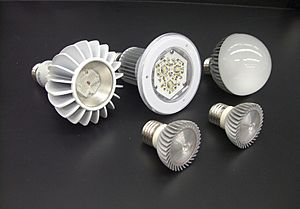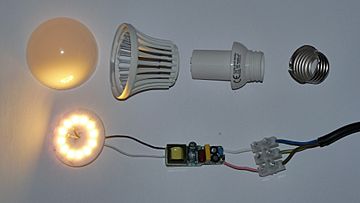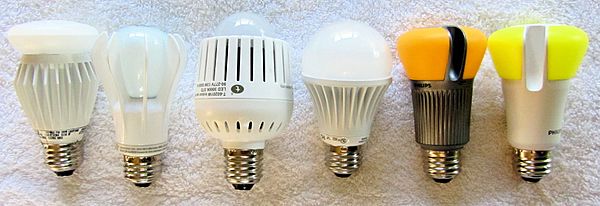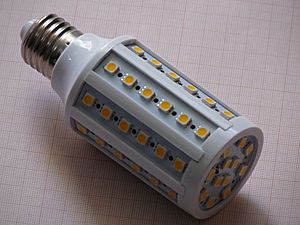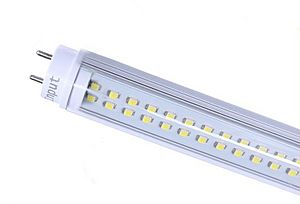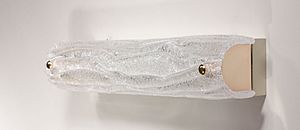LED lamp facts for kids
A LED lamp is a special kind of lamp or light bulb that uses tiny lights called LEDs. These lamps last much longer than old-fashioned incandescent bulbs. They also use less electricity, which means they are more efficient. Many LED lamps are even better than fluorescent lamps.
Unlike fluorescent lamps, most LED lamps turn on instantly. They don't need to "warm up" to give off their full light.
Contents
How LED Lamps Are Used
LED lamps are used for many different kinds of lighting. They are great for general lighting in homes and offices. They are also perfect for special lighting needs. If you need a colored light, LEDs can make that color directly. This means they don't waste energy by using filters.
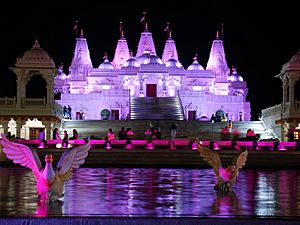
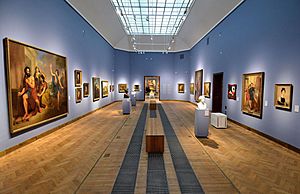
White LED lamps last a long time. They are also very efficient, meaning they give more light for the same amount of electricity. This is true when they are used at the right temperature. LEDs are small, which makes it easy to design cool light fixtures. You can also control where the light goes using small reflectors or lenses. Because LEDs are so tiny, you can easily control how the light spreads. You can even change the light's brightness and direction without losing energy.
LEDs can mix colors to create a huge range of shades. They do this by changing how much light comes from each main color (like red, green, and blue). This allows for full color mixing in lamps that have different colored LEDs. Unlike other lights, LED light usually shines in one direction. This can be good or bad, depending on what you need. If you need light to spread everywhere, you can use a special cover called a diffuser. Or, you can use many small LEDs pointing in different directions.
LED Lamps for Your Home
Sizes and Bases for LED Lamps
LED lamps are made to fit into standard light bulb sockets. They come in common shapes and sizes. For example, many have an Edison screw base, which you twist into the socket. Others might have a bi-pin base, like the MR16 shape. They also come with a GU5.3 (two-pin cap) or GU10 (twist-and-lock fitting). These lamps are made to work with the electricity from your home's sockets. They have special parts inside that change the AC power into the right voltage for the LEDs.
Around 2010, some LED lamps could replace very bright older bulbs. For example, one company said their 16-watt LED lamp was as bright as a 150-watt halogen lamp. A regular incandescent bulb is not very efficient. It gives off about 14 to 17 lumens of light per watt of electricity. To be considered energy-efficient in the European Union, a lamp that replaces a 60-watt incandescent bulb must give off at least 806 lumens of light.
Some LED lamps can even work with dimmers that you use for incandescent lamps. LED lamps often shine light in a specific direction. They use less power than compact fluorescent lamps. They also last a very long time, often 30,000 hours or more. However, if they get too hot, their lifespan might be shorter. Incandescent lamps usually last about 1,000 hours. Compact fluorescents last around 8,000 hours. LED lamps keep their brightness well throughout their life. Energy Star rules say that LED lamps should lose less than 10% of their brightness after 6,000 hours.
LED lamps come in many different colors of light. They cost more to buy than most other lamps. But because they use so much less electricity and last so long, the total cost (buying the bulb plus electricity and changing bulbs) is often lower.
Many companies now sell LED lamps for general lighting. This technology is getting better very quickly. New, energy-efficient LED lamps are always becoming available for homes.
By 2016, LED lamps were becoming the main type of light source in the United States. Their prices were falling, and older 40-watt and 60-watt incandescent lamps were being stopped. In the U.S., a law called the Energy Independence and Security Act of 2007 basically stopped the making and importing of most incandescent lamps. LED lamp prices have dropped a lot. Many types are even sold at lower prices thanks to help from local power companies.
LED Tube Lamps
LED tube lights are made to fit into the same light fixtures as fluorescent tubes. Some LED tubes can simply replace the old fluorescent tubes if the right ballast (a part in the fixture) is used. Others need the fixture to be rewired to remove the ballast. An LED tube lamp usually has many small LEDs that shine in one direction. This means you need to put them in the right way. Fluorescent tubes, on the other hand, shine light all around. Most LED tube lights can replace T8, T10, or T12 fluorescent tubes. T8 tubes are 26mm wide, and T10 tubes are 30mm wide. They come in lengths of 590 mm, 1200 mm, and 1500 mm.
Lighting Designed for LEDs
Newer light fixtures are now being designed specifically for LED lamps. Some even have long-lasting LEDs built right into them. This is happening as there's less need for new lights to fit old fixtures. These new lights don't need each bulb to have special parts to work with home electricity.
LEDs for Growing Plants
Scientists have found that plants grow surprisingly well under LED lights. Many types of vegetables and ornamental plants have been tested in greenhouses. The results show that the quality of these plants, including their health and important chemicals, is as good as, or even better than, plants grown outdoors. Mint, basil, lentil, lettuce, cabbage, parsley, and carrot all grew well. Some ornamental flowers like primula, marigold, and stock also bloomed beautifully.
LEDs are great for growing plants because they can provide the exact colors of light plants need (like red and blue). This helps plants grow faster and with better quality and quantity in greenhouses. Since LEDs don't get very hot, plants can be placed very close to the lights. This prevents the plants from overheating or getting burned. This also saves a lot of space, allowing more plants to be grown in a smaller area.
Special Uses for LED Lamps
White LED lamps are now very popular where using little power and being very efficient is important. This includes things like flashlights, solar-powered garden lights, and bicycle lights. Single-color LED lamps are now used for traffic signals. Their ability to make bright, clear colors is a big advantage. They are also used in holiday light strings. LED car lights are used a lot because they last a long time and are small. Their small size allows for many bulbs, which can make driving safer. LED lamps are also becoming popular in homes, especially for bathroom and medicine cabinet lighting.
Images for kids
-
An 80-watt Chips on board (COB) LED module from an industrial light. It's attached to a heat sink to keep it cool.
See also
 In Spanish: Lámpara led para niños
In Spanish: Lámpara led para niños


